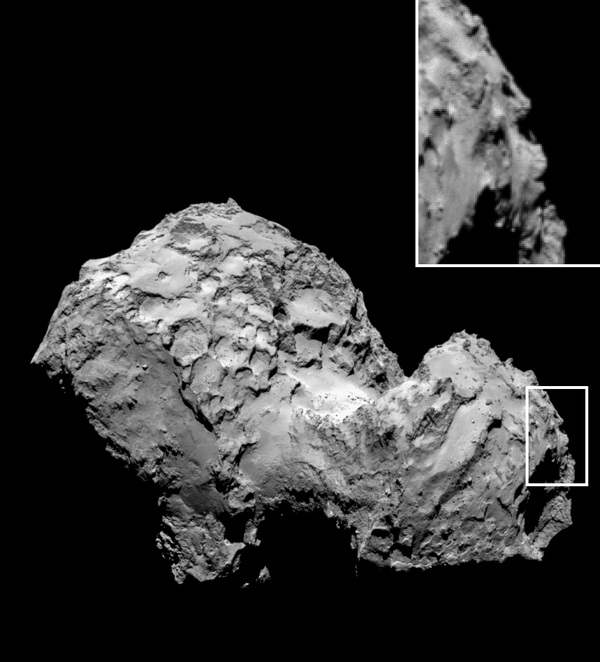Why is there a "Face" on Comet 67P in Photos from the Rosetta Spacecraft?
| Ana Verayo | | Aug 10, 2014 03:38 AM EDT |
(Photo : ESA) A human face? A photo taken by the Rosetta spacecraft of Comet 67P.
The European Space Agency's Rosetta spacecraft has just entered the orbit of Comet 67P Churyumov-Gerasimenko and new photos show the comet seems to be "smiling" at the spacecraft.
After shuttling from Earth to Mars and into deep space during a fantastic10-year journey, Rosetta finally reached its target comet, 67P Churyumov-Gerasimenko,last week.
Like Us on Facebook
Images beamed to Earth by Rosetta captured some unusual "human-like features" on the comet's surface from an altitude of 62 miles above the comet.
The new photographs show some craggy outlines of a human profile made from rock and ice on the icy comet's surface.
This phenomenon is quite common in space photography and these "human faces'" are merely optical illusions. This is called "pareidolia," a phenomenon where the brain recognizes familiar objects or subjects and associates them with unknown entities.
Some other famous optical illusions on heavenly bodies include the "Man on the Moon" taken from the 1902 film classic "Journey to the Moon," the "Cookie Monster" on Mercury and the famous "Face on Mars."
The "Face on Mars" is a controversial photograph taken by NASA's Viking 1 Mars orbiter in 1976 that distinctly shows a grim human face looking upwards at the stars.
Further observation from other spacecraft such as NASA's Mars Global Surveyor and Europe's Mars Express debunked this "face," which scientists said was caused by a play of light and shadows.
Some nebulae are also called by names of known objects they resemble such as the Crab Nebula, the Eye of God and the Horsehead Nebula, among many others.
Officials at the German Aerospace Center's youth portal first commented on this optical illusion, which first appeared on social networking site, Twitter.
Throughout August, Rosetta will map the surface of 67P, orbiting the comet in a triangular trajectory that will allow scientists to gather more data about the comet's shape and gravitational field. The comet's shape is said to resemble that of a rubber duck.
The Rosetta mission was launched in March 2004 from ESA's Guinea Space Center in Kourou, French Guiana in South America.
Rosetta intercepted 67P on August 6 after travelling an astounding four billion miles in humankind's longest space chase to date.
Tagsspacecraft arrives on target comet, first spacecraft to land on comet, NASA's Viking 1 Mars, NASA's Mars Global Surveyor, 67P/Churyumov-Gerasimenko, 67p comet, 67p comet photos, comet photos human face, human face space photography, pareidolia, rosetta, man on the moon, why is there a human face on comet, first photos 67p comet, photos rosetta comet
©2015 Chinatopix All rights reserved. Do not reproduce without permission
EDITOR'S PICKS
-

Did the Trump administration just announce plans for a trade war with ‘hostile’ China and Russia?
-

US Senate passes Taiwan travel bill slammed by China
-

As Yan Sihong’s family grieves, here are other Chinese students who went missing abroad. Some have never been found
-

Beijing blasts Western critics who ‘smear China’ with the term sharp power
-

China Envoy Seeks to Defuse Tensions With U.S. as a Trade War Brews
-

Singapore's Deputy PM Provides Bitcoin Vote of Confidence Amid China's Blanket Bans
-

China warns investors over risks in overseas virtual currency trading
-

Chinese government most trustworthy: survey
-

Kashima Antlers On Course For Back-To-Back Titles
MOST POPULAR
LATEST NEWS
Zhou Yongkang: China's Former Security Chief Sentenced to Life in Prison

China's former Chief of the Ministry of Public Security, Zhou Yongkang, has been given a life sentence after he was found guilty of abusing his office, bribery and deliberately ... Full Article
TRENDING STORY

China Pork Prices Expected to Stabilize As The Supplies Recover

Elephone P9000 Smartphone is now on Sale on Amazon India

There's a Big Chance Cliffhangers Won't Still Be Resolved When Grey's Anatomy Season 13 Returns

Supreme Court Ruled on Samsung vs Apple Dispute for Patent Infringement

Microsoft Surface Pro 5 Rumors and Release Date: What is the Latest?










